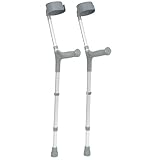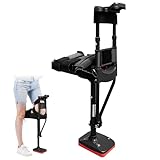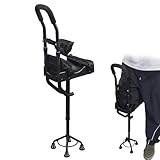When facing injury, surgery recovery, or long-term mobility needs, many people ask: Which crutches are right for me? Crutches are designed to provide balance, reduce weight on injured legs, and support safe movement. However, not all crutches are the same, different styles and features suit various users. This guide explains the types of crutches, important features, and considerations to help you choose the best option for your comfort and mobility.
Understanding Crutches
Crutches are assistive devices that transfer weight from your lower body to your upper body, enabling mobility while reducing strain on injured legs, ankles, or feet. The right crutches not only support recovery but also improve stability and confidence in daily movement.
When deciding which crutches are right for me, it’s helpful to understand the main categories of crutches.
Types of Crutches
1. Underarm (Axillary) Crutches
These are the most common type, with a padded top that sits under the arms and handgrips for support. They are usually adjustable in height.
- Best for: Short-term injuries, such as sprains, fractures, or recovery from surgery.
- Pros: Affordable, widely available, good stability.
- Cons: Can cause underarm irritation and fatigue if used long-term.
2. Forearm (Elbow) Crutches
Forearm crutches typically feature a cuff that wraps around the forearm and a handgrip for added control. They are commonly used in Europe and for longer-term mobility needs.
- Best suited for: Long-term use, managing chronic conditions, and individuals seeking improved posture.
- Pros: Encourages upright posture, reduces the risk of underarm pain, and improves mobility control.
- Cons: Require upper body strength and coordination.
3. Platform Crutches
Platform crutches use a horizontal platform to rest the forearm while holding a vertical handle. They are ideal for people who cannot bear weight on their wrists or hands.
- Best for: Users with arthritis, weak grip, or wrist injuries.
- Pros: Reduce wrist strain, comfortable for prolonged use.
- Cons: Bulkier and less common than other crutch types.
4. Hands-Free Crutches
Hands-free crutches strap onto the leg, allowing users to walk more naturally without holding traditional crutches.
- Best for: Active individuals recovering from lower-leg injuries.
- Pros: Keeps hands free and allows for a more natural walking motion.
- Cons: Not suitable for everyone; balance and strength required.
Key Features to Consider
When asking which crutches are right for me, evaluate these features:
- Adjustability – Height-adjustable crutches ensure proper fit.
- Weight Capacity – Always check maximum weight limits.
- Comfort – Cushioned grips and pads reduce strain during long use.
- Durability – Aluminium crutches are lightweight, while steel models are more durable.
- Foldability – Foldable designs are ideal for travel or occasional use.
Matching Crutches to Health and Lifestyle
For Short-Term Injuries
Underarm crutches are generally sufficient for sprains, fractures, or post-surgery recovery.
For Long-Term Conditions
Forearm crutches are more ergonomic and suitable for daily use.
For People with Wrist or Hand Problems
Platform crutches provide stability without stressing the wrists.
For Active Lifestyles
Hands-free crutches allow greater freedom and natural mobility.
Fitting Crutches Correctly
Improperly fitted crutches can cause pain or even further injury. General fitting tips include:
- Underarm crutches: The top should be 1–2 inches below the armpit when standing upright.
- Handgrips: Elbows should bend at about 30 degrees when holding grips.
- Forearm crutches: Cuffs should fit snugly below the elbow without restricting movement.
If you are unsure, always seek professional advice from a physiotherapist or mobility expert.
Practical Buying Tips
- Consult a Healthcare Professional – Always seek advice before making a purchase.
- Consider the Intended Use – Short-term vs. long-term, indoors vs. outdoors.
- Check Safety Features – Anti-slip rubber tips improve stability.
- Look at Weight – Lightweight crutches are easier to use for extended periods.
- Try Before You Buy – Comfort and fit vary between users.
Real-Life Scenarios: Which Crutches Are Right for Me?
- Recovering from a broken ankle? Underarm crutches.
- Living with a chronic mobility condition? Forearm crutches.
- Struggling with arthritis in the wrists? Platform crutches.
- Need freedom of movement for work or hobbies? Hands-free crutches.
Caring for Your Crutches
- Replace Tips Regularly – Worn tips reduce traction and can cause slips.
- Check Bolts & Adjustments – Ensure they are secure before each use.
- Clean Frequently – Keep grips and pads hygienic, especially for long-term use.
- Store Properly – Avoid damp areas to prevent wear and tear.
Conclusion
Which crutches are right for me? The answer depends on your injury, mobility needs, and lifestyle. For short-term recovery, underarm crutches are an effective option. For long-term conditions, forearm crutches provide better comfort and posture. Platform crutches are the best option for wrist problems, while hands-free crutches are ideal for active users.
By considering type, fit, comfort, and durability, you can choose crutches that support your mobility, safety, and independence.
























